#scaffolding china
Video
youtube
Formwork Clamp
#youtube#formwork#shoring#formwork clamps#formwork accessories#shoring accessories#formwork clips#formwork parts#wellmade scaffold#wellmade#china#manufacturer
0 notes
Text

A major project👍
1 note
·
View note
Text
Currently in mainland China, in a restaurant.
On the second floor with family, however…
THE GROUND IS BOUNCING WITH EVERY MOVEMENT!?!?!?
Like, not just shaking. Trembling, like an earthquake. It feels like it’s gonna collapse with every step. Holy crap.
Anyways, here’s some images of the food:


#I swear this isn’t legal#there’s no structures supporting it#it’s just a fancy scaffolding#kinda scared rn holy crap lol#at least the food is great#food#restaurant#mainland china#irl
0 notes
Text
0 notes
Text
something something “you know me better than anyone has ever known me” something something “I loved you. best I could”, something something Familiarity breeds contempt, relationships as self-context, someone who knows your past may be in the worst spot to understand your potential for change, emotional inertia, cycles of abuse, so on—
A lot of people think Izzy is fooling himself with that line. And sure, Izzy Hands didn’t know that Ed killed his own dad. But Izzy knew Ed wasn’t actually fine, after Stede left. He wasn’t getting *better* with the depression robe and the singing. He was just running, again. From himself, his actions, his emotions. Again. And Izzy has lived through *decades* of Ed pulling that kind of shit, of deflections and obfuscation. He miscalculated, yeah. But Ed wasn’t going to get better if Izzy had just kept his mouth shut. Something was going to set him off, sooner or later. Because Ed still hasn’t grown from the guy who sets people on fire and has them skinned with oyster forks then slumps through weeks long depression cycles.
Nothing about Ed and Stede’s first relationship actually forced Ed into confronting his own self-compartmentalization (and boy can a bitch compartmentalize. The Kraken, Izzy being the one to kill him in the dream, Hornigold, who he was with Jack, Jeff the accountant, just Ed—babygirl at some point you are going to have to decide who you are if you ever stand a chance of getting what you want). They were going to run away to China because it meant NEITHER of them had to deal with being the people who have done what they’ve done. If Stede and Ed had made it off that island together then they wouldn’t have grown.
On the flip side, Izzy was never going to be able to save Ed from himself because their relationship was static before meeting Stede. They’ve been together for so long that nothing Izzy says *counts* as new input (the first genuinely surprising thing Izzy ever does in-show is surviving killing himself). Iz is an extension of Ed, which is why he’s subject to torture and derision and punishment in a way no one else was. Ed fucking HATES himself. Izzy is a part of him.
So, yeah. Ed loved Izzy the BEST that he could love himself—poorly, mercilessly, as willing to hack off parts of Izzy’s body as he was entire facets of his own personality and history. So Izzy was never going to pull Ed out of the suicidal pit he’s been in for years. Knowledge, knowing someone, that doesn’t mean insight. Izzy’s so close to Ed that their perspective is practically a perfect overlay. There’s no new angles, no way to see where the light could shine through.
That’s why Ed needed Stede. The complete and total lack of context allowed Stede to take Ed as he was, to question him and force Ed to ask questions of himself that Izzy simply was not capable of. Ed is a social chameleon—he changes himself constantly to fit the image he thinks other people have of him. Stede refuses to provide the Blackbeard scaffold. There’s no context to cling to, no familiar script to follow. Stede has his own narratives and pre-conceived notions, but they’re NEW.
Context, perspective—you need both to get a whole image of a person. Maybe Stede and Izzy working together this season will finally be enough to help Ed see himself in a light that allows him to love what he sees in the mirror.
669 notes
·
View notes
Text

You know how I love offbeat properties and I found this seller's For-Sale-By-Owner ad on Zillow. He started building the home in 1969, in Eureka, California, and it's been under construction for 43 years! It's a French ornamented cathedral Gothic, with all custom ornaments, molds and scaffolding techniques. This mansion is based on Newport, Rhode Island style and spirit from the 19th Century.

This is what it's supposed to look like - The Vision.


And, in 43 yrs., this is what he's done so far. He's asking $4.5M. Now, he has been living in it, so you can live in the finished part. The house is being sold furnished, and what furnishings! Read what he wrote about them below:

"Also for sale here are 1500 sq. ft of the ultimate grade palatial antique Italian marquetry, veneer and solid wood furniture, ranging from console tables and mirrors; 10 different sizes of round antique tables, up to a 12' x 6' museum-piece dining table, various rare cabinets, marquetry, upholstered chairs, couches, china and other cabinets, solid gold (plated) grandfather clock and two huge antique chandeliers, all worth over $300k on the market now and arguably TWICE that!"

This outer door is amazing.

Here's a gargoyle and other ornamentation that still has to go on the house.

But, look at this - it says the exterior designs are ready for installation "when the lawsuit is over." So, the property is involved in a lawsuit, too? (Check the blog - I found the lawsuit papers and posted it.)

There's so much stuff here.

This room is done. It must be a ballroom. I don't know what to make of all this. This looks like the Romanoff's place.

This must be a music room. There's a harpsicord and a harp in here.
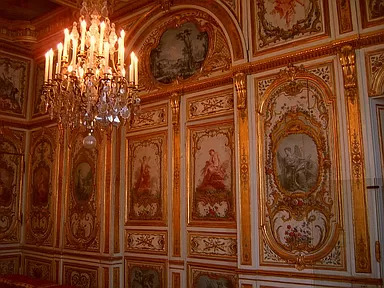
Look at these walls. He says the walls are hand done- are these the actual walls?

The walls are hand painted according to the description.
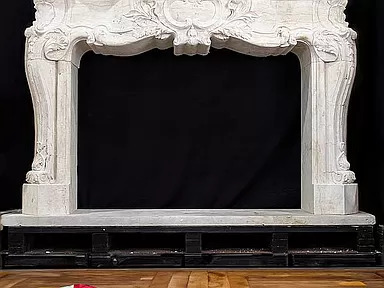
Here's a mantel waiting to be installed.
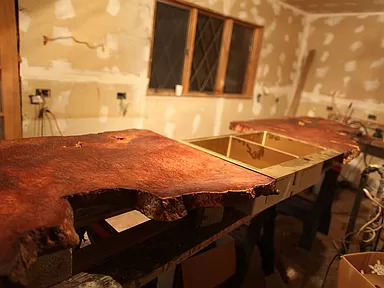
This is going to be the kitchen.

The gold double sink.

I don't know if this is an old picture of the original inspiration for this home, but it's definitely a representation of the home itself.

This is an amazing fireplace.

Another beautiful fireplace.

He's using the bedroom, but it's not finished.

I'm disappointed in this bathroom. Maybe it's just temporary?

He has a lot of photos of the furniture and these are really primo antiques. So, this would be one of the dining rooms.

This looks like a brand new bedroom set. Looks like a furniture store that used to be near me called Roma Furniture.

The chandelier in the ballroom that he says is included in the sale.

One of the sitting rooms.

Nice inlaid table.

There's a lot of furniture. If you want to see it all, click on the link b/c he's posted 100 photos. But, I'm very confused.



The property measures 6 acres and there are "massive fall color and rose gardens, 20,000 plantings, plus 10,000 daffodil, iris, lily, etc. Bulbs are spread over 6 acres, still there mostly, alive and colorful. Plus, hundreds of valuable landscaping sculptures are included."
121 notes
·
View notes
Text
Sand Sea (Tomb of the Sea) Whump List

Summary: When high school student Li Cu is attacked, a map is carved into his back and he is then kidnapped by a man named Wu Xie. Li Cu is forced to go on a journey to a forbidden tomb and thrust into a long-running conflict where he has to play a vital role if he wants to come out alive.
Genre: Action, adventure, mystery, supernatural
Country: China
Year: 2018
Watch it on: Viki, YouTube
Spoilers ahead...

Whumpee: Li Cu played by Wu Lei (Leo Wu)
Episode 1: Disoriented, struggling to stand, chased, yelling in frustration and fear, says he was kidnapped, (flashback to before the kidnapping) manhandled, locked in a closet, scared, slides down the wall, crying, begging to be let out, released when he gives in to his father’s demands; a mysterious black form enters his forehead, knocked out of his seat, holding his head in pain; attacked on the street, a hand placed over his mouth, pushed against a wall, calling for help, strangled, holding his throat, coughing, knocked out, falls to the ground, has something carved into his back, rushed to the hospital; in a hospital bed, wakes up in pain, struggles to walk, horrified at the sight of his back, crying, kidnapped from the hospital
Episode 2: Manhandled, yelling in pain, wounds on his back reopened, passed out; told he has to go to the desert with the people who kidnapped him, wincing in pain
Episode 3: Forced to go down into tunnels even though he is claustrophobic
Episode 4: Scared; dragged over a cliff, saved
Episode 5: Knife held to the back of his neck
Episode 6: Scared; panics; struggling to breathe, holding his neck, falls to the ground, passes out
Episode 7: Falls down a cliff, unconscious; told he is hallucinating due to claustrophobia; hanging over a cavern with one person holding on to him
Episode 9: Stranded in the desert with no food or water
Episode 10: Caught in a sandstorm; weak from dehydration, stumbling, collapses, passes out
Episode 11: Flashback to when he was attacked; nightmare
Episode 12: Arm cut with a cleaver (x3), wincing in pain
Episode 13: Punched in the face, bloody nose
Episode 14: Punched in the face, falls to the ground, eyes go black, in a fight, at knifepoint, manhandled (being held back), chased, drowning
Episode 15: Knocked to the ground by a giant root; scared, chased (by a root monster thing); groaning in pain, says it’s his back
Episode 16: Forced to sleep; tied with rope, hanging from a crane, dropped to the ground, grunting in pain, grabbed around the ankle by a root, dragged, grabbed around the waist, pulled back, saved
Episode 17: Gun pointed to the side of his head; complaining about his back hurting; groaning in pain (from his back)
Episode 18: Pulled down by his ankle, choked, rescued, bitten by a snake, has a vision of the past; made to stand in various poses that make his back hurt; falls from scaffolding, nearly falls into a mine shaft
Episode 19: Pain in his hand, passes out, has a vision, wakes with a gasp
Episode 20: Wakes up in a hospital bed, flashback to him unconscious on a gurney, grabs his head, says he doesn’t remember what happened to him; hit in the back, falls to the ground, kicked repeatedly
Episode 21: Gets his hand stuck in a dummy, in pain
Episode 22: Nearly abducted, saved
Episode 31: Flashback to some of the traumatic things he encountered
Episode 32: Hallucinating; bit by things in a lake, yelling in pain
Episode 33: Drugged, knocked into a lake
Episode 34: Grabbed by the ankle, dragged off by the snake tree; helped to stand
Episode 36: Thrown across the room, groaning in pain, caught in an explosion, knocked unconscious, blood on his head; coughing up blood
Episode 37: Groaning in pain, has an injured leg, covered in blood, captured, bitten by a snake, has a vision, held in down, grabbed by his shirt collar
Episode 38: Forced to go with his enemies, carried on someone’s back; at knifepoint, kicked in the chest (while sitting), falls into a mine cart, groaning in pain, manhandled, captor steps on his bad leg, breathing heavily, grabbed by the hair, captor threatens to break his back, grabbed by the back of his shirt; forced to walk on his bad leg, manhandled
Episode 39: Helped to walk (but not in a friendly way), in pain; limping, falls unconscious after making eye contact with a snake; limping, knocked onto his back by a dog
Episode 40: Helped to walk, pushed to the ground, grabbing his leg in pain, punched in the face; pushed to the ground, straddled, crossbow pointed at his face, crossbow pushed into his injured leg, grunting in pain
Episode 41: Caught in an explosion, passes out; wakes up back with his captors, half dragged, half carried
Episode 42: Weak, carried on someone’s back, helped to stand, drugged
Episode 43: Wakes up in a strange place, IV in his arm, cast on his leg, collapses, passes out
Episode 44: Held down, drugged
Episode 46: Gun pointed to the back of his head, forced to read a bunch of snake pheromones, grunting in pain, shaking
Episode 48: In a fight, knocked to the floor bleeding from the mouth; forced to read more pheromones, sick, slides down a wall
Episode 50: Shot with a dart, passes out; used as a human shield, gun pointed to his neck
Episode 51: Shot at, chased, hiding; crying, sees his friend die in front of him; chased, shot at
Episode 52: Shot at, in a fight; kicked through a wall (kind of), nearly stabbed, thrown out a window; carried on Wu Xie’s back, blood on his head; wakes up alone on a train, bandage on his head, arm in a cast; reunited with his friends, crying
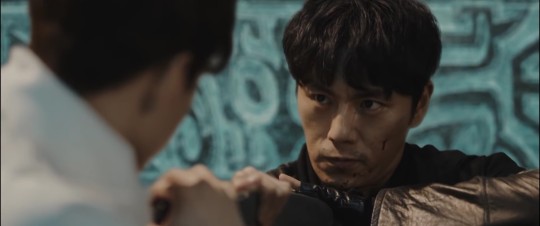
Whumpee: Wu Xie played by Qin Hao
Episode 2: (In a story) blood on his face, in a fight
Episode 6: Threatened with a knife
Episode 7: Falls down a cliff; hanging over a cavern with two people holding on to him, falls, trapped
Episode 8: Threatened
Episode 9: Stranded in the desert with no food or water
Episode 10: Caught in a sandstorm; held at knife-point; weak from dehydration, stumbling, collapses
Episode 12: Infected by a worm, tied up (for his protection); has the worm cut out of him, passes out; holding his side
Episode 14: Gun pointed to the side of his head, at knifepoint, manhandled (being held back), chased
Episode 15: Root grabs him by the ankle, dragged through sand
Episode 18: Bit by a snake; in a trance
Episode 19: In a trance, asked to be tied up
Episode 36: (Flashback) bitten by a snake
Episode 39: Drives his car off a mountain
Episode 40: Attacked, in a fight, falls off a cliff
Episode 42: Caught in a blizzard
Episode 45: Passed out, carried on someone’s back
Episode 50: Poisoned, falls to his back, left for dead
Episode 51: Unconscious, woken up, helped to sit; shot at
Episode 52: In a fight, kicked in the chest; crying

Whumpee: Su Wan played by Wang Hao Xuan
Episode 3: Kicked into a room with no floor, hanging from (bamboo?) scaffolding; locked in a room
Episode 7: Believes Li Cu is dead, crying
Episode 8: Kind of kidnapped
Episode 9: Being watched, chased, saved
Episode 26: Lightly manhandled; tied to a chair, gagged (with a hand then packing tape), gets free, chased, punched in the face, bloody nose, caught, held in place, strangled (with a rope), rescued; bitten by a snake, falls unconscious, carried on a friend’s back, bleeding from the nose
Episode 27: In a hospital bed
Episode 28: In a hospital bed, bandage on his neck
Episode 33: Drugged, knocked into a lake
Episode 34: Bit by something, yelling in pain, given a shot; helped to walk; complaining that he doesn’t feel good, knocked across the room by a giant snake, passes out
Episode 36: Unconscious, carried on someone’s back, blood on his face
Episode 38: Chased
Episode 39: Unconscious after jumping off a cliff, weak, helped to sit
Episode 40: Trapped in a pit
Episode 41: Trapped in a pit, weak
Episode 42: Stuck in a collapsing cave
Episode 52: Crying
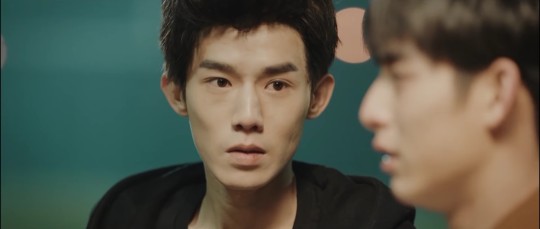
Whumpee: Yang Hao played by Zhu Jian
Episode 3: Kicked into a room with no floor, hanging from (bamboo?) scaffolding; locked in a room
Episode 9: Being watched, chased, saved
Episode 27: Hits himself on the head with a brick, blood running down the side of his head
Episode 33: Drugged, knocked into a lake
Episode 40: Manipulated into believing his friend betrayed him; knocked over, told he is worth nothing, bullied
Episode 41: On the ground, forced onto his back, punched in the face; caught in an explosion; falls underground, blood on his face
Episode 42: Face covered in blood, worried about Li Cu
Episode 43: Discovers his grandmother passed away while he was gone, crying
Episode 44: Emotional pain
63 notes
·
View notes
Text

Helping Heal Bone
A 3D-printed scaffold with cryogel fibres incorporating vessel growth- and bone formation-enhancing peptides for promoting bone regeneration at the site of skull damage or defect
Read the published research article here
Image from work by Yuxuan Wei and Hao Pan, and colleagues
Zhejiang Engineering Research Center for Tissue Repair Materials, Wenzhou Institute, University of Chinese Academy of Sciences, Wenzhou, Zhejiang, China
Image originally published with a Creative Commons Attribution 4.0 International (CC BY-NC 4.0)
Published in Science Advances, February 2024
You can also follow BPoD on Instagram, Twitter and Facebook
16 notes
·
View notes
Text
🎨 Journey + Hush + Labyrinth + Regret 🎨
Promptober 2023
Print / Trinket Universe (Kylian and Bluebell)
~2000 words
Warning: Dehumanization, fearplay
A sequel to this story. These were the only two stories I planned for this month about Kylian and Bluebell, but you can expect more in the future. 😉
@marydublinauthor

Bluebell was a woman of many talents and skills. Cleaning was not one of them. This was especially troubling because there were no other openings available for prints at the time she took the job. And changing roles was unheard of—she should be so grateful to have a job in the first place.
Thankfully, the fellow prints and even the human members of her crew were easily charmed. But was sure she was on thin ice despite that.
Kylian Hart, the owner of the estate she cleaned every Monday and Thursday afternoon, surely wanted her dead—or, at least fired.
Ever since he caught her dancing around in front of his mirror like an idiot, he glowered at her whenever they crossed paths. Even when she averted her gaze and hurried off to find something to clean, she was aware of his gaze following her like a lead weight.
He was probably waiting for the opportunity to pounce—ready for the moment she would do something frivolous and stupid again. It had been two weeks since the incident, and every time she had to return to the sprawling house, her stomach curdled with fear.
If Mr. Hart had complained to her supervisor, Bluebell hadn’t gotten wind of it yet. Which meant, for some reason, the enigmatic artist was keeping her slip-up to himself. That only put her more on edge. Any time now, he would fire her when she least expected it. She’d learned from the others that he had sent away cleaners for even less. Prints who were fired from a high-profile assignment like this were dismissed from the company entirely.
Against all odds, cleaning rich people’s ridiculous homes was a high-value job among prints. I’m grateful, she told herself over and over, as though it might nullify the karma that was chasing her. I’m very, very grateful.
If she lost this job, she doubted she’d find another. She wouldn’t starve—not when she had a way with charming meals from the neighbors in the slums. But it would mean having no money to wire to Aster. Not that she sent much, though it was something. And the wire transfer was one of the few ways she could assure him that she was still alive.
“Where are you off to, Blue?” Elara, one of the prints on the crew, spotted Bluebell wandering away while they were supposed to be polishing the contents of a china cabinet.
Bluebell barely needed the movable scaffolding to reach the floor. She landed lightly, slinging a rag over her shoulder with a warm smile. “Off to get a head start on the next room, sunshine. I feel so clumsy around all that fancy stuff, anyway.”
Elara gave a short laugh. “Please. You could do cartwheels around these things without leaving a smudge. But go on. The sooner we’re out of here, the better.” She lowered her voice conspiratorially. “Can’t stand the way he skulks around like a ghost.”
A wry smile stayed painted on Bluebell’s face as she exited the room. He’s skulking ‘cause of me, sunshine.
When she reached the next room, she didn’t stop. The timing wouldn’t get any better than now. This was the floor she needed to be on. The humans on the crew, somewhat nice or not, wouldn’t have let her wander off again. Although they didn’t know about the incident, her penchant for vanishing hadn’t gone unnoticed.
She stayed close to the wall, winding her path toward the studio that Mr. Hart caught her in. Maybe if she apologized in person, he would have mercy on her. Maybe, just maybe, he would appreciate her bravery in speaking up.
Silly, ditzy me. Can’t help myself when I see a mirror. You know how rare a clean mirror is in the slums? Rare, Mr. Hart, very rare. I hope you don’t think that’s how I spend my afternoons here, though. I work so very hard. And I’m grateful. So very grateful.
Much like the first time she meandered into the room, it was open just a crack. The lights were off, and the curtains were drawn as she peeked her head inside. The hallway fixtures provided just enough illumination to confirm that Mr. Hart wasn’t there—and that there were several new canvases set up around the room.
Although her heart sank that she wouldn’t get her chance to apologize right then, her attention was drawn to the canvases that towered high overhead. She squinted. When she last intruded into the studio, there had been a few sketches pinned to the walls and books stuffed on shelves, but not much else to look at.
Her gaze remained fixed on the nearest canvas. She could make out a figure. One that looked like… But no, it couldn’t be. She was seeing things.
Get out. He’s not here. Go.
But she had to know.
Grunting, she pushed her entire body against the door to widen the opening. The hinges were well-oiled enough, but the weight of the wood proved to be cumbersome. She managed to widen the net of light from the hallway that fell into the room. Panting from exertion, she looked up to see the canvas—and its neighbors—properly.
She would have gasped, but her lungs refused to take air. She staggered further into the room, unable to comprehend what she was seeing.
All five of the canvases—even the new sketches pinned to the walls—were her.
“Holy hell,” she breathed.
Most of her likenesses were full-body portrayals. Blue skirts, dark hair, dancing poses in motion. All kinds of expressions, too—from full-blown grins to pensive frowns.
He had been watching her.
She didn’t know how long she stood there, gaping, but she didn’t know what snapped her out of it—footsteps thudded down the hall, fast approaching.
Bluebell cursed under her breath. It was him. No one else in this house would dare walk as loudly as he did. She couldn’t bolt out the door—he’d see her. She scrambled further into the room and ducked under the table, praying and praying that he would simply pass the studio.
The door creaked open wider. The footsteps entered. The light flicked on. The door shut firmly.
She cowered against the wall, hiding among the clutter. Boxes of half-used art supplies and scraps of crumpled sketching paper created a maze around her. Clearly, Mr. Hart had not allowed anyone to clean this room in ages. Thank heavens that worked in her favor.
Polished shoes approached. She pressed herself hard against the wall, covering her mouth to keep from screaming. He settled into his chair. After a moment, she heard a harried scrape of pencil on paper.
Another sketch of her?
Bluebell stepped gently to the side, looking past the clutter to catch a glimpse of the door. There was a wastebasket there, surrounded by more wads of paper. If she could huddle behind the basket, she could flee whenever he opened the door again.
She turned her attention to his shoes and slowly, slowly crept against the floor molding. With all her attention fixed on him, she didn’t pay attention to her path. A pencil lay at her feet, and she stepped squarely upon it. A squeal burst past her lips as she dropped hard to her hands and knees.
The sketching stopped.
“Who’s in here?” His voice was vicious.
His shoes scraped against the floor as he stood, shoving the chair back. Cowering in the soft puddle of her skirts, she looked around desperately for a hiding place. Perhaps one of the boxes—but the world rattled, making it impossible to think clearly. Massive hands dug at the clutter, determined to leave her with nothing to hide behind. Clawing fingers almost blindly took her into their grasp.
She bolted, slipping expertly among the boxes, but it was no use. He shoved one of the containers so hard that it knocked into her. Pain lanced through her body as she was forced into the open—right into his glare’s path.
His hand descended and squeezed her into a tight grip. A scream wanted to come out, but she didn’t have the air to produce it. A pathetic whimper came out instead as he dragged her out from under the table. Her legs hung over empty air, her stomach churning from the sudden ascent before her captor’s eyes.
All at once, his murderous glare snapped into surprise. His grip loosened, nearly dropping her, but his other hand shot up to stop her fall. She gasped for air and bowed her head while she gathered her bearings. He said nothing, so she scrambled to fill the silence.
“I-I’m sorry,” she stammered. Both hands were around her, leaving her entirely at his mercy. After what she had seen in the studio—from the art to the bite of his glare—her inner speech abandoned her. All she could produce was a whispered, “I work so hard. I’m very grateful. I-I…”
“I didn’t know it was you,” he said, filling the pause after she trailed off. His tone was unreadable, and she couldn’t bear to look him in the eye.
She nodded shakily, wishing he would put her down. “It’s me,” she confirmed with a high little laugh. “I was just going to apologize about the other day, and I…” She chanced a look at the canvases around her, then winced.
He stood, carrying her with him effortlessly to the tabletop. He dropped her onto the surface. Her breath caught. He had, in fact, been sketching her. She could see the outline of her heart-shaped face taking form on the paper. The table was littered with blue pencils and markers. She swallowed hard and scooted back on her rear, wondering what he would do with her now that she’d seen his work.
“I-I… I should get back,” she said hoarsely. “They’ll start to wonder if I’m taking a nap somewhere.” She gave a forceful giggle. “N-not that I would ever—”
“You don’t like them?”
She blanched. He regarded her stonily.
“W-what?” she asked. “Oh. The—” She wet her lips and blinked around the studio. Something sinister crawled beneath her skin, but she forced another dainty laugh. “The me’s. I just… Sir, I just don’t understand why…” She pointed at herself and smiled cluelessly.
Don’t play dumb. You love the attention. Well, here it is.
Mr. Hart steepled his fingers imperiously, leaning the lower half of his face behind his hands. She dared to look higher and meet his gaze. She hadn’t noticed before—he looked less disheveled than usual. Hair combed back instead of messy. Clothing neat instead of rumpled. Facial hair was shaved close to his skin. Maybe he’d looked like that every time he glared at her the past weeks—she’d just been too afraid to look at him long enough to notice.
“I thought you looked compelling.” His voice sounded matter-of-fact, yet small behind his hands. Almost bashful.
A bizarre silence followed. He watched her closely, his stare digging into her face like hot knives. Was he taking the opportunity to examine her more closely for his next piece—or did he truly care about her reaction to his work?
As if that reaction could be anything less than undying appreciation and awe. He had her cornered. If she displeased him… Disappearances weren’t uncommon. Her crew and neighbors might mourn her for a few days—their charming little mascot lost.
Only Aster would really care—but she was more or less dead to him already.
Still, self-preservation took hold.
She fixed her expression into a bashful smile as she cowered before him. She batted her eyes coquettishly. Little old me?
“I’m… so very touched, sir,” she said.
For the first time since she’d ever laid eyes on him, Mr. Hart looked pleased.
#gt#g/t#giant tiny#gt writing#g/t writing#gt fearplay#g/t fearplay#gt fandom#g/t fandom#gt community#g/t community#my writing#print universe#print universe story#trinket universe#trinket universe story#printverse#printverse story#oc: kylian#oc: bluebell#promptober 2023
44 notes
·
View notes
Text

Chapter 4. Environment
No philosophy or movement for liberation can ignore the connection between human exploitation of the environment and our exploitation of one another, nor can it ignore the suicidal ramifications of industrial society. A free society must forge a respectful and sustainable relationship with its bioregion, on the understanding that humans depend on the health of the entire planet.
What’s to stop someone from destroying the environment?
Some people oppose capitalism on environmental grounds, but think some sort of state is necessary to prevent ecocide. But the state is itself a tool for the exploitation of nature. Socialist states such as the Soviet Union and People’s Republic of China have been among the most ecocidal regimes imaginable. That these two societies never escaped the dynamics of capitalism is itself a feature of the state structure — it necessitates hierarchical, exploitative economic relationships of control and command, and once you start playing that game nothing beats capitalism. However the state does present the possibility of forcibly changing people’s behavior on a massive scale, and this power is attractive to some environmentalists. There have been a few states in world history that enforced protective measures domestically, when saving the environment coincided with their strategic interests. One of the foremost is Japan, which halted and reversed deforestation in the archipelago around the Meiji period. But in this case and other cases, domestic environmental protections enforced by the state were coupled with greater exploitation abroad. Japanese society consumed increasing amounts of imported wood, fueling deforestation in other countries and providing an incentive for the development of an imperial military to secure these vital resources. This led not only to environmental devastation but also to warfare and genocide. Similarly in Western Europe, statist environmental protections came at the expense of colonial exploitation, which also resulted in genocide.
In smaller-scale societies, the existence of an elite tends to fuel environmental exploitation. The renowned social collapse on Easter Island was caused in large part by the elite, who compelled the society to build statues in their honor. This statue-building complex deforested the island, as large numbers of logs were needed for scaffolding and transportation of the statues, and farmland to feed the laborers came at the expense of more forests. Without forests, soil fertility plummeted, and without food the human population plunged as well. But they didn’t just starve or decrease their birth rate — the clan elites warred with one another, knocking down rival statues and carrying out raids that culminated in cannibalism, until nearly the entire society died off.[62]
A decentralized, communal society with a commonly held ecological ethos is the best equipped to prevent environmental destruction. In economies that value local self-sufficiency over trade and production, communities have to deal with the environmental consequences of their own economic behaviors. They cannot pay others to take their garbage or starve so they can have an abundance.
Local control of resources also discourages overpopulation. Studies have shown that when the members of a society can directly see how having too many children will diminish the resources available for everyone, they keep their families within a sustainable limit. But when these localized societies are incorporated into a globalized economy in which most resources and wastes are imported and exported, and scarcity results from seemingly arbitrary price fluctuations rather than the depletion of local resources, populations climb unsustainably, even if more effective forms of contraception are also available.[63] In Seeing Like a State, James Scott explains how governments enforce “legibility” — a uniformity that enables comprehension from above, in order to control and track subjects. As a result, such societies lose the local knowledge necessary to understand problems and situations.
Capitalism, Christianity, and Western science all share a certain mythology regarding nature, which encourages exploitation and contempt, and views the natural world as dead, mechanical, and existing to satisfy human consumption. This megalomania masquerading as Reason or Divine Truth has revealed itself beyond all doubt to be suicidal. What is needed instead is a culture that respects the natural world as a living, interconnected thing, and understands our place within it. Bruce Stewart, a Maori writer and activist, told an interviewer, pointing to a flowering vine he had planted by his house,
This vine no longer has a name. Our Maori name has been lost, so we’ll have to find another. Only one of this plant remained in the world, living on a goat-infested island. The plant could go any day. So I got a seed and planted it here. The vine has grown, and although it normally takes twenty years to bloom, this one is blooming after seven.
...If we are to survive, each of us must become kaitiaki, which to me is the most important concept in my own Maori culture. We must become caretakers, guardians, trustees, nurturers. In the old days each whanau, or family, used to look after a specific piece of terrain. One family might look after a river from a certain rock down to the next bend. And they were the kaitiaki of the birds and fish and plants. They knew when it was time to take them to eat, and when it was not. When the birds needed to be protected, the people put a rahui on them, which means the birds were temporarily sacred. And some birds were permanently tapu, which means they were full-time protected. This protection was so strong that people would die if they broke it. It’s that simple. It needed no policing. In their eagerness to unsavage my ancestors Christian missionaries killed the concept of tapu along with many others. [64]
Tikopia, a Pacific island settled by Polynesian people, provides a good example of a decentralized, anarchic society that has successfully dealt with life-and-death environmental problems. The island is only 1.8 square miles in area and supports 1,200 inhabitants — that is, 800 people per square mile of farmland. The community has existed sustainably for 3,000 years. Tikopia is covered in multi-storied orchard-gardens that mimic the natural rainforests. At first sight, most of the island appears to be covered in forest, though true rainforests only remain on a few steep parts of the island. Tikopia is small enough that all its inhabitants can become familiar with their entire ecosystem. It is also isolated, so for a long time they could not import resources or export the consequences of their lifestyle. Each of the four clans have chiefs, though these have no coercive powers and play a ceremonial role as the custodians of tradition. Tikopia is among the least socially stratified of the Polynesian islands; for example, the chiefs still have to work and produce their own food. Population control is a common value, and parents feel it is immoral to have more than a certain number of children. In one striking example of the power of these collectively held and reinforced values, around the year 1600 the islanders reached a collective decision to end pig-breeding. They slaughtered all the pigs on the island, even though pig meat was a highly valued food source, because keeping pigs was a major strain on the environment. [65] In a more stratified, hierarchical society, this might have been impossible, because the elite would typically force poorer people to suffer the consequences of their lifestyles rather than give up an esteemed luxury product [66].
Before colonization and the disastrous arrival of missionaries, population control methods on Tikopia included natural contraception, abortion, and abstinence for younger people — though this was a compassionate celibacy that amounted to a prohibition on reproduction rather than on sex. Tikopians also used other forms of population control, such as infanticide, that many people in other societies would find impermissible, but Tikopia can still provide us with a perfectly valid example because with the effectiveness of modern contraception and abortion techniques, no other methods are necessary for a decentralized approach to population control. The most important feature of the Tikopian example is their ethos: their recognition that they lived on an island and resources were limited, so that increasing their population was tantamount to suicide. Other Polynesian island societies ignored that fact and subsequently died off. The planet Earth, in this sense, is also an island; accordingly, we need to develop both global consciousness and localized economies, so we can avoid exceeding the capacity of the land and stay aware of the other living things with whom we share this island.
Today most of the world is not organized into communities that are structured to be sensitive to the limits of the local environment, but it is possible to recreate such communities. There is a growing movement of ecologically sustainable communities, or “ecovillages,” organized on horizontal, non-hierarchical lines, in which groups of people ranging from a dozen to several hundred come together to create anarchic societies with organic, sustainable designs. The construction of these villages maximizes resource efficiency and ecological sustainability, and also cultivates sensitivity to the local environment on a cultural and spiritual level. These ecovillages are at the forefront of developing sustainable technologies. Any alternative community can degenerate into yuppie escapism, and ecovillages are vulnerable to this, but a leading part of the ecovillage movement seeks to develop and spread innovations that are relevant to the world at large rather than to close itself off from the world. To help proliferate ecovillages and adapt them to all regions of the globe, and to facilitate coordination between existing ecovillages, 400 delegates from 40 countries met in Findhorn, Scotland, in 1995 and established the Global Ecovillage Network.
Each ecovillage is a little different, but a few examples can provide an idea of their diversity. The Farm, in rural Tennessee, has 350 residents. Established in 1971, it contains mulch gardens, solar-heated showers, a sustainable shiitake mushroom business, straw bale houses, and a center for training people from around the world to build their own ecovillages. Old Bassaisa, in Egypt, contains a few hundred residents and has existed for thousands of years. The residents have perfected an ecological and sustainable village design from traditional methods. Old Bassaisa now contains a Future Studies center, and they are developing new sustainable technologies like a methane gas producing unit that extracts gases from cow manure to save themselves from having to use scarce firewood. They use the leftover slurry as fertilizer for their fields. Ecotop, near Dusseldorf in Germany, is an entire suburb with hundreds of residents living in several four-story apartment buildings and a few detached homes. The architecture fosters a sense of community and freedom, with a number of communal and private spaces. Between the buildings, in a sort of village center, is a multi-use courtyard/playground /pedestrian zone, as well as community gardens and an abundance of plants and trees. The buildings, which have a completely modern, urban aesthetic, were constructed with natural materials and designed with passive heating and cooling and biological on-site wastewater treatment.
Earthhaven, with about 60 residents, was founded in 1995 in North Carolina by permaculture designers. It is composed of several neighborhood clusters set in the steep Appalachian hills. Most of the land is covered in forest, but the residents recently made the difficult decision to clear some of the forest for gardens so they could come closer to food self-sufficiency rather than exporting the costs of their lifestyle by purchasing food from elsewhere. They talked about it a long time, prepared themselves spiritually, and attempted to clear the land in a respectful way. This sort of attitude, which capitalist ideology would dismiss as sentimental and inefficient, is exactly what could prevent destruction of the environment in an anarchist society.
Also necessary are fierceness and the willingness to take direct action to defend the environment. On the isthmus of Tehuantepec, in Oaxaca, Mexico, anarchist and anti-authoritarian indigenous people have shown exactly these qualities in protecting the land against a series of threats. Organizations such as the Union of Indigenous Communities of the Northern Zone of the Isthmus, UCIZONI, which includes one hundred communities in Oaxaca and Veracruz, and later the anarchist/Magonista group CIPO-RFM, have fought against the environmentally devastating construction of wind farms, shrimp farms, eucalyptus plantations, and the expropriation of land by the lumber industry. They have also reduced economic pressures to exploit the environment by setting up corn and coffee cooperatives and building schools and clinics. Meanwhile, they have created a network of autonomous community radio stations to educate people about dangers to the environment and inform the surrounding communities about new industrial projects that would destroy more land. In 2001, the indigenous communities defeated the construction of a highway that was part of Plan Puebla Panama, a neoliberal megaproject intended to connect North and South America with transportation infrastructure designed to increase the flow of commodities. During the Zapatista rebellion of 1994, they shut down transportation lines to slow down the movement of troops, and they also blocked highways and shut down government offices to support the 2006 rebellion throughout Oaxaca.
In 1998, the Minnesota Department of Transportation wanted to reroute a highway through a park in Minneapolis along the confluence of the Minnesota and Mississippi rivers. The proposed reroute would destroy an area that contained old trees, a precious oak savanna ecosystem, an ancient freshwater spring, and sites sacred to Native Americans — a vital wild space in the middle of the city that also served as a refuge for many neighbors. Indigenous activists with the American Indian Movement and the Mendota Mdewakanton Dakota Community came together to work in coalition with white residents, environmentalists from Earth First!, and anarchists from all over the country to help stop the construction. The result was the Minnehaha Free State, an autonomous zone that became the first and longest-lasting urban anti-road occupation in US history. For a year and a half, hundreds of people occupied the land to prevent the Department of Transportation from cutting down the trees and building the highway, and thousands more supported and visited the Free State. The occupation empowered countless participants, reconnected many Dakota people with their heritage, won the support of many neighbors, created a yearlong autonomous zone and self-organizing community, and significantly delayed the destruction of the area — buying time during which many people were able to discover and enjoy the space in an intimate and spiritual way.
To crush the occupation, the state was forced to resort to a variety of repressive tactics. The people at the encampment were subjected to harassment, surveillance, and infiltration. An army of police officers raided and destroyed the camps repeatedly; tortured, hospitalized, and almost killed people; and carried out over a hundred arrests. In the end, the state cut down the trees and built the highway, but the protestors did manage to save Coldwater Spring, which is a sacred site to the area’s indigenous peoples and an important part of the local watershed. The Native participants declared an important spiritual victory.
People throughout Minneapolis who had initially supported the destructive project because of its supposed benefits to the transportation system were won over by the resistance to save the park, and came to oppose the highway. If the decision had been up to them, the highway would not have been built. The Free State created and nurtured coalitions and community bonds that last to this day, shaping new generations of radical community and inspiring similar efforts around the world.
Outside Edinburgh, Scotland, eco-anarchists have had even more success saving a forest. The Bilston Glen anti-roads camp has existed for over seven years as of this writing, drawing the participation of hundreds of people and stopping the construction of a bypass desired by large biotech facilities in the area. To allow people to live there permanently with a lower impact on the forest, and to make it harder for police to evict them, the activists have built houses up in the trees which people occupy year round. The village is certainly low technology, but it is also low impact, and some of the houses are clearly works of love, comfortable enough to be considered permanent homes. The dozen or so inhabitants have also been tending the forest, removing invasive species and encouraging the growth of native species. The Bilston Glen tree village is just one in a long line of anti-road occupations and ecological direct actions in the UK that create a collective force that makes the state think twice about building new roads or evicting protestors. The village also crosses the line between simply opposing government policy and creating new social relations with the environment: in the course of defending it, dozens of people have made the forest their home, and hundreds more people have personally seen the importance of relating with nature in a respectful way and defending it from Western civilization.
#environmentalism#environment#solarpunk#anti colonialism#anarchism#daily posts#communism#anti capitalist#anti capitalism#late stage capitalism#anarchy#anarchists#libraries#leftism#social issues#economy#economics#climate change#anarchy works
6 notes
·
View notes
Text


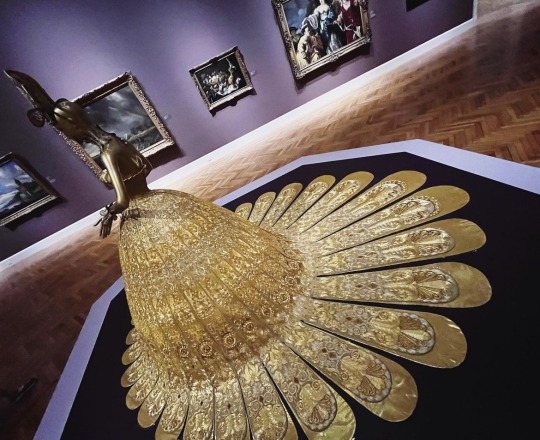

San Francisco's Legion of Honneur museum offers a dazzling selection of Guo Pei’s magnificent haute couture gowns created from 2006 to the present. Considered to be the first Chinese haute couturier, Guo Pei grew up during the Chinese Cultural Revolution, a tumultuous period where anything belonging to China’s Imperial past - traditions, script, literature, arts and antiquities, family histories and property - were all forbidden or destroyed. With an inexhaustible vocabulary of traditional motifs (lotus, Buddha, dragon, lilies, peacocks) woven onto sumptuous gold thread, “Guo Pei creates a fantasy that fuses the influences of China’s imperial past, decorative arts, European architecture, and the botanical world.” As imposing as the garments are, they also seem to poke fun at the spiritual and cultural weight of couture and Chinese traditional values. In several of her architecture series pieces, she uses bamboo strips, a material usually used as throwaway building scaffolding, in constructing Edwardian-style hoop skirts with boned corsets. In another couple of pieces from the same collection, she references Gothic cathedrals in monochrome embroidery on silk gauze: One can see pointed arches, flying buttresses, and stained glass sections placed where the wearer’s chest would be. Formerly reserved by law for the royal court, yellow silk dragons make their appearance time and again over gowns, deconstructed epaulets, even chaps held up by gold ribbons.
7 notes
·
View notes
Video
youtube
Scaffold Base Plate - Steel Fixed Scaffold Feet for Scaffolding Poles - ...
#youtube#scaffold base plate#fixed base plate#base plate#steel plate#steel scaffolding plate#scaffold feet#wellmade china#wellmade
0 notes
Photo

Polymers with a metal backbone
Until now, it has been clear: you can have a metal or a plastic, but not both in one. However, things don't have to stay that way. In the journal Angewandte Chemie, a Chinese research team has now reported a polymer with a metallic backbone that is conductive, thermally stable, and has interesting optoelectronic properties.
Because of the different electronic structures of metal and nonmetal atoms, it is difficult to confer the properties of metals, such as high thermal and electrical conductivity, upon polymers. Polymers with a metal backbone could combine the advantages of both types of material and open routes to materials with novel functionality. The problem lies in the weak bonds between the metal atoms, which cannot stabilize a polymer backbone to the same extent as the nonmetal atoms of conventional polymers. A team led by Guowei Wang and Huisheng Peng has now successfully synthesized a stable polymer with a backbone made of nickel atoms.
The team at Fudan University and East China University of Science and Technology (Shanghai, China) used a chalice-shaped molecule (calixarene) with four binding sites as the "scaffold" for the metal polymer. They attached four poly(aminopyridine) chains to the calixarenes, which bundles the four chains and aligns them in parallel. Synthesis of the chains can be carried out stepwise from individual building blocks or several larger blocks can be linked together.
Read more.
26 notes
·
View notes
Note
Regarding shipping, didn't hima give few hints on what he sees as canon ships in anime and manga- like gerita, fruk and rochu(russia stalking china with his panda costume, wearing chinese clothes and eating food in his house)? Also, isn't rochu heavily hinted like fruk?
hmm, if you're referring to my post about multi-shipping—tbh, my personal approach is that i don't really care what is "canon" in the anime and manga? that's not to say there aren't a lot of elements of the canon hetalia character designs/dynamics/concepts i enjoy, but confining myself to it feels rather restrictive (as opposed to building upon it/modifying it). especially when the manga has its flaws, and there's the breadth of world history to pull from. I just can't see nations as being monogamous for life—even for fruk, which is an otp; i like shipping them both with others too.
as to ro/chu, personally it isn't my cup of tea. but if i wanted to explore them more in depth—i don't find that^ good scaffolding for a compelling romantic dynamic either? just my personal opinion as (1) person of asian bg, but those scenes felt more like jokes or references to the way china was wary of russia after the opium wars—or the future sino-soviet rivalry. it's one of those things where my past experiences seeing fics employing stereotypes personally turned me off that dynamic: i.e ivan being written as an eastern european mobster stalking yao (who was fetishised in a very orientalist way). while i don't ship it, i will definitely say there is a lot of detailed real-world sino-russian and sino-soviet history to pull from—and to me that's much better material for fleshing them out as a three-dimensional relationship. same with fruk—there are certainly funny scenes with them in the manga, but the main reason i love them together is because there's that long anglo-french history we can write in.
so yeah—my overall approach isn't to be restricted by what is/isn't "canon" in the manga, because i personally don't find it realistic for nations to be monogamous (especially someone as old as Yao, who has such complicated relationships and ties with so many other nations). and there's just so much more i feel we can add to their characters by looking beyond canon. it's the way i usually treat "canon" in all fandoms i've been in too; canon might be the foundation and inspiration—but the fun is in transforming it too.
32 notes
·
View notes
Note
what did you think of nick land?
you asked this in past tense as though i just met him at a dinner party. why, he was loud and he used all the gravy. what a rude man!
here’s my real, very long answer: [2.4k words]
obviously today he is a miserable racist toad who goes on and on about the blockchain and woke capital. and after he moved to China he worked as an actual CCP propagandist. so he's not my hero. but thats the late era. early era: his earliest stuff is really good. i have mostly handled his first paper, Kant, Capital and the Prohibition of Incest (1988). the thing is, his scholarship in this essay isn't very good. he makes a huge argument about the development of capitalism, the situation in South Africa, the development of the family and so forth, yet it has only 11 citations, all to Kant, Levi-Strauss, Nietzche, Marx, Luce Iriguay and Monique Wittig. none of his historical or economic argument interacts with history or economics (the Marx citation is just for the page number for the quoted phrase "so-called primitive accumulation", which he uses without operationalizing), and his anthropological claims rest on the already yellowing pages of Levi-Strauss's 1947 book on kinship structures. further, in handling Levi-Strauss he makes, i believe, two errors: 1. he grounds the entire discussion in the 'dual-organization' which is, correct me if i'm wrong, just the first part of the book, and if you included the rest of the material it'd work a lot less as a just-so story (the highest page number citation to Levi-Strauss is 88, the whole book is over 500 pages—you can literally see where he gave up reading), and 2. he assumes that Levi-Strauss’s theories about contemporary non-industrial societies are equally true about prehistoric societies. he doesn’t even mention that he’s doing that, he just implicitly treats the book as a description of the arbitrarily distant ontogenesis of whatever genealogy is under discussion. take the duplicity in the first paragraph that he cites Levi-Strauss:
In The Elementary Structures of Kinship Claude Levi-Strauss notes the frequent distinction made by various societies between normal and 'rich food' (op. cit. pg 8; all page numbers correspond to the pdf)
which is that normal food is produced within the moiety and ‘rich food’ is imported from outside the moiety through gifting or exchange. that this is a ‘frequent’ distinction in ‘various’ societies is as much background as we get; from now on we act like it’s an essential feature of all societies. skip to the end of the paragraph,
If 'rich food' is the primordial element of trade its metamorphosis into the modern 'commodity' can be seen as... [he uses this to scaffold an argument about Enlightenment philosophy] (ibid.)
this distinction Levi-Strauss ‘noted’ in ‘various’ contemporary nonindustrial societies has quietly become the PRIMORDIAL source of the commodity form. if you’re going to project Levi-Strauss’s observations into the past like that you’re really going to need to make the argument that you can. but the truth is that you can’t. this has been a pernicious trend in virtually every field, from anthropology to biology to philosophy, discussed in (for example) this 1978 paper (that’s ten years, we remind the reader—and feeling a little good about ourselves while we do it—before Land’s article was publsihed) Myths About Hunter-Gatherers by anthropologist Carol R. Ember,
I take issue wtth the belief that we are entitled to infer from [information about contemporary hunter-gatherers] what cultural patterns must have been typical in the distant past. We know, for example, that there is substantial variation among recent hunter-gatherers in residence, subsistence, division of labor, and warfare. If these variations are the result of different causal conditions, then what has been "typical" in recent times may only be a statistical artifact of the recent prevalence of certain causal conditions.
in a 2001 review of an unlikely book called Hierarchy in the Forest by Christopher Boehm, which makes a similar assumption about the historical utility of information from contemporary hunter-gatherer societies, she reflects on her argument in this paper, writing “I have argued such an assumption is problematic, especially since extant foragers live in very marginal enviornments” while historical foragers occupied optimal enviornments. so if there is such a widespread distinction between normal and ‘rich’ food, that’s certainly interesting, but we’re very far from saying it’s a primordial distinction emanating from prehistory, as opposed to one resulting from the interaction of similar societies in marginal enviornments, if we can’t specify the causal conditions of that cultural distinction. all of this is a lot of ink to spend on one claim, which is not even the most outrageous claim in that paragraph. in the middle he writes that,
The difference between rich food and normal food maps onto the difference between filiation (relation by blood) and alliance (relation by marriage). This is because rich food occupies the position of women within a marriage system regulated by patrilineal exogamy, with its producer renouncing it for himself, and thus echoing the prohibition of incest.
this one cultural distinction ‘maps onto’ this other cultural distinction. why? because one part ‘occupies the position’ of something else in the other one. and that ‘echoes’ still a third cultural practice. huh? why? nevermind—it’s time to talk about Kant instead. it’s remarkable that this passed peer review at all. in fact, that’s probably why it was published in the miscellany section of Third Text (vol 2 no 5, 1988), a journal of art criticism, which in those early days published more articles by sculptors and designers than academics. the issue before this one contains a glowing review of Black Athena: the Afroasiatic Roots of Classical Civilization. you get the idea—Nick Land was always a bit of a crank.
wait a minute, didn’t i start off saying it was really good? yeah. i still think so. the reason its so frustrating is the overall argument in this paper is really good. Land’s case is that capitalism relies on a continuous process of primitive accumulation (the aggregation of wealth through enclosure, robbery, slavery and so forth), but that this economic process creates political conditions—mutiny, revolt, unrest—which place capitalism in danger. thus, to handle this threat primitive accumulation was outsourced goegraphically to colonies, and internally to ghettos and bantustans, which quarantine the political consequences of accumulation (“I say that these colonies are not costly, they are more faithful, they injure less, and the injured, as has been said, being poor and scattered, cannot hurt”—Machiavelli). this quarantining creates a racial 'other’ which makes and continually renews the opportunity for cultural exogamy, the kind that ruled the world pre-captialism because of the incest taboo. but capitalist society, and capitalist thought, in fact rejects this exogamous exchange, and retreats to a kind of endogamy—anti-miscegnation, militarized borders, and so on, except that, due to capitalism’s dependence on a primitive accumulation quarantined to the racial other, the racial other can never be fully excluded, and this endogamy is always in trouble. racism is, therefore, patriarchy’s nervous, unsuccessful self-transvaluation in response to the demands capitalism places on it, and this triggers a meltdown of the incest taboo (’inhibited synthesis’) which appears twice, once in the economic sphere—as the commodity form—and again in philosophy—as the synthetic a prori, an ‘alterity already inscribed within the system’ (paraphrase; op. cit. pg 9). the revolutionary solution Land proposes is (taking the opposite side to Shulmith Firestone, who also read the oppression of women through Levi-Strauss’s dual-organization, until she decided women’s liberation was bound up with the abolition of the incest taboo) a radical exogamy, an embrace of alterity even at the cost of self-dissolution. xenophilia. lesbian vampires. jungle. meltdown has a place for you . . .
you get the picture. its a beautiful theory. the relationship he describes between economics, politics and culture is very convincing to me, even if the particulars can’t be the way he says, since he’s using old, outdated sources—and using them badly. and the connection with philosophy he supposes is too clumsy to me—of course there must be some relationship, but the way he wants to approach it is pretty unclear. and yeah, its still a just-so story, that conveniently ties women’s liberation, anti-racism, anti-colonialism, and anti-capitalism all together into one program, all while conserving a role for philosophers like him. i don’t know where the argument that primitive acculumation is a continuous feature of capitalism started. i know it was a big part of Federici’s thought after a certain stage, and it gets a completely explicit statement in Anti-Oedipus: “So true is it that primitive accumulation is not produced just once at the dawn of capitalism, but is continually reproducing itself” (pg 251). the chapter is the Civilized Capitalist Machine, the same one we get the name ‘accelerationism’ from. they get there by engaging with a bunch of economics papers and marxist writers. and if you thumb a few pages back in the book you’ll get to the chapter called Barbarian or Imperial Representation (pg 220), which is about incest, which also introduces the idea of a relationship between the incest taboo and alliances. and for a piece of writing that contains the spontaneous utterance “O Caligula, O Heliogaba-lus, O mad memory of vanished emperors!” in the middle of a paragraph (pg 222), the scholarship is a lot more serious than in Land’s essay, connecting ethnographic work with information about writing systems and other data, criticisms of psychoanalytic theories, and even finding time for Nietzsche—who’s also in Land’s essay. so perhaps there are some of Land’s fingerprints on a copy somewhere. but all of this is a bit unfair, because we’re holding Land to certain academic standards, certain styles of reasoning and methods for handling (or, indeed, providing) evidence, which are, for Nick Land, the very thing at stake.
look here, if i thought the only worthwhile way to write nonfiction was to make 15 pages of inductive reasoning, with every ‘t’ crossed and every citation sourced, and send it off to Mind i wouldn’t be writing stream-of-consciousness rants on tumblr every day. there are other things to write, other impulses writing can capture, and other audiences waiting with other methods of reading. over the course of the 90s Land and his buddies would build a bit of a walled garden, not just the actual CCRU, but a subculture of ‘para-academic’ writers, speakers, and artists who very rarely reference anyone outside their hermeneutic circle, and who no one outside of their hermeneutic circle ever references. this is the attack on Reza Negarestani made by goodreads user Paul (a former Heidegger scholar, Nazi history revisionist, conservative Chrsitian and race realist) in his review and comments, who remarks that continental philosophy has “fringes full of charlatans who cite/publish each other”, before he types up a long angry rant to one critic, questioning his credentials: “Seriously, can you give me a list of the books you've read by Kant and about Kant (in the original languages if possible), and who you studied with? Have you passed doctoral comps on any of these figures or taught them to others?” to him, Negarestani & Land are charlatans who create a cult around themselves in order to sell the books they print on their own vanity presses. and i am, i admit, a little suspicious of them myself—Reza and Land both founded this online school where you pay thousands of dollars to get an MFA in ‘Post-Planetary Universal Design’ over Google Hangouts and Google Classroom, or you can pay a few hundred dollars to attend seminars on Bahktain (this institution is apparently accredited). Land was fired for being racist btw. are those things worth going to? for a quarter of that price i could get a whole course on the astrological significance of the newly discovered dwarf planets from A Bigger Picture Astrology. IMAGINE A YOD
IN THE ASTROLOGICAL SKY FOR
SEVEN YEARS. . .
anyway, rightfully or wrongfully suspicious—you can’t just say all that and forget that there was this thing called the CCRU, there was this thing people believed in called Accelerationism, and so on, as though writing is just writing and books are just books. the small minded world that Paul comes from—this is something they were trying to outrun. it has something of the character of the Surrealist Bureau of Research, or the Acéphale Society, and things like that. why make a walled garden out of your philosophy? why cultivate a non-academic audience? why meet in secret, play jungle music, hallucinate? the writing only affirms the milieu. like a manifesto. and today the milieu around those people isn’t worth being part of. discussion hovers around announcing in-group affiliation: this is deterritorialized and based, that is striated and cringe. another review of Reza’s book, this time from one of the faithful, says it “could do with more embodiment and affect and libido altho an interesting read regardless.” if this is the image of thought the CCRU was able to achieve then it wasn’t worth doing. but maybe there is something else, deep in there, still running free. idk.
i want to compare it with the anarchist milieu. sometimes anarchist writing is quite rigorous; Endnotes, Chuang, even Desert pay careful attention to the bibliography. but if you go and read anything on the anarchist library, the scholarship might not get better than Land’s, and it might even get worse. Aragorn! was prone to unargued proclamations like this: “The Russian Revolution was not won with an army; the Bolsheviks filled a power vacuum created by the handling of the German war and missteps of the Provisional Government” (Anarchy & Strategy). is that true? how do you know? well, those sound like provocative questions when i write them like that. but Aragorn! could count on a literate audience, since anarchists debate those events and theories day after day in our practical lives. we have an oral tradition, a shared intellectual context, a way of spreading and innovating on information. this platform can interact with academic literature, but it doesn’t become academic. anarchist pamphlets are written in the imperative mood, or the interrogative. they advise, excite, provoke, challenge a reader who is assumed to be engaged in anarchy. orientation. navigation. songspirals.
conversely, who was Land writing to in the 80s and 90s? the people that read some little journal? people who buy scary books? i understand trying to outrun academia, but why stay an academic? isn’t it just that they all were academics, since they took philosophy when they were 18, and we’re back to facing Nietzsche's prognosis in We Philologists, “A man chooses his calling before he is fitted to exercise his faculty of choice.” or was there some good reason, and something potentially very exciting about the space they had, the milieu, the audience, that made it worth doing? i don’t know, i’d have to read a lot more, or speak to someone who was invovled. things like that. but those are the things i’m thinking about when it comes handling to Nick Land.
139 notes
·
View notes
Text
OK, so, something I've been doing recently is working out what legal charges the antagonists of TTTE would face if we suspend our disbelief and imagine locomotives having to stand trial in a court of law.
Diesel (various episodes and specials throughout the show's run)

3 counts of destruction of property: damaging disused trucks. Pushing trucks into the harbour resulting in the loss of a consignment of china clay. Wasting an entire flat truck’s worth of paint.
3 counts of defamation: Spreading negative rumours about Gordon, James, and Henry.
1 count of frameup: Pinning the blame of the rumours on Duck.
1 count of attempted murder: Trying to get Fergus scrapped.
3 counts of assault: Bumping Thomas under a stone hopper. Bumping paint cans onto Thomas. Bumping Toby into a coal hopper.
Sailor John (Legend of the Lost Treasure)
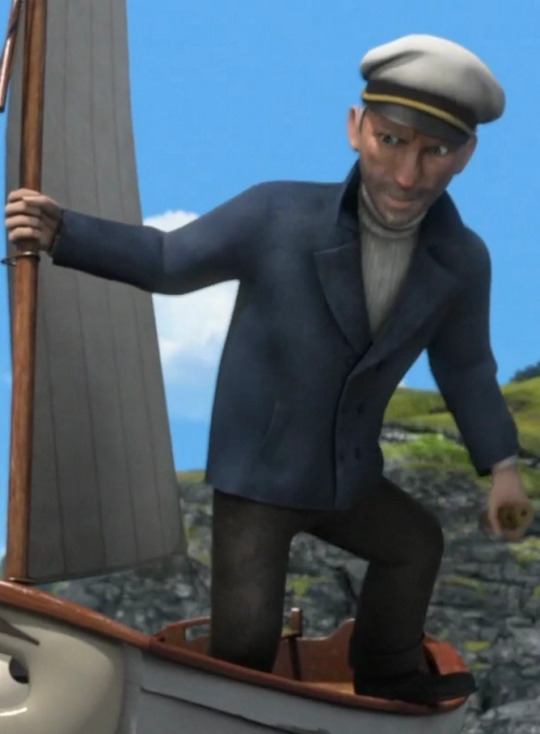
4 counts of assault: stamping his foot on Skiff, elbowing Skiff to silence him, stamping on skiff AGAIN, battering thomas with an oar
4 counts of trespassing: riding Skiff on the construction site of the new branchline (3 counts). Entering the station out of regular hours
1 count of coercion: manipulating Thomas into his scheme to steal the treasure.
4 counts of theft: stealing the map, the stealing the treasure, stealing explosives, stealing a warship.
2 counts of intimidation: accusing thomas of taking the treasure for himself, threatening skiff with physical harm for “mutiny”.
1 count of unlawful possession of explosives.
1 count of breaking & entering: breaking into Sir Topham Hatt’s office.
1 count of destruction of property: using DYNAMITE to break into Sir Topham Hat’s safe.
1 count of vehicle hijacking: running amok with the ship on a flat wagon (lets ignore the physical improbability of this for the moment).
1 count of public endangerment: same reason as vehicle hijacking.
2 counts of attempted murder: trying to dynamite Thomas, leaving Thomas to drown.
And possibly also 1 count of prison break: he's seen in a later special (Big World: Big Adventures) in a cafe in brazil. Assuming this isn't just the studio reusing him as an asset as a background character this implies he escaped from prison and fled to brazil.
Diesel Ten (Thomas And The Magic Railroad & Day Of The Diesels)

7 counts of attempted murder: Lady twice, James, Junior, Mr Conductor, and Thomas (TATMR), Thomas (DOTD).
3 counts of property damage: Carving his likeness on the rock which would be the property of the landowner, tearing down the scaffolding of the sheds, bringing down the diesel shelter (TATMR).
3 counts of Intimidation: The sheds, Mr Conductor on the Viaduct, and carrying Junior on his roof (TATMR).
1 count of conspiracy to commit genocide (wanting ALL steam locomotives scrapped): "I'm going to destroy her and dominate you, then you'll be nothing but hunks of useless scrap" (TATMR).
1 count of reckless driving: driving at excessive speed with Junior on his roof (TATMR).
1 count of unlawful imprisonment: Trapping Thomas in the shed (DOTD).
1 count of arson: setting fire to the shed (DOTD).
1 count of coercion: manipulating Percy into unwillingly assisting him in goals (DOTD).
1 count of trespassing: entering the dieselworks without the knowledge or permission of Victor (DOTD).
1 count of conspiracy to commit grand larceny: attempting to take control of the dieselworks (DOTD).
1 count of theft: stealing a christmas tree.
Verdict: Diesel is toxic, Sailor John is a pirate, and Diesel Ten is standing trial in the Hague for crimes against trainkind and small children
29 notes
·
View notes